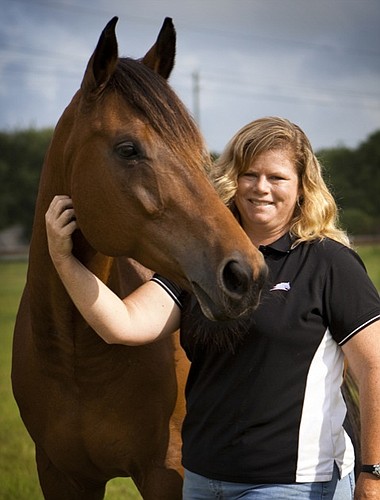Donna Blem is one of only 150 licensed Parelli Natural Horsemanship trainers in the world — a real life horse whisperer.
But Blem has spent much of the past year whispering a different tune: How to guide a nonprofit through the crippling recession by running it like a for-profit business. Blem is the executive director of Sarasota-based InStride Equine Assisted Therapy, an organization that provides therapeutic horse rides to children and some adults with disabilities and movement dysfunctions.
Blem's success is based on a combination of nimble decision-making and sheer will and persistence. In her success there also lies a lesson for entrepreneurs in the for-profit world: Always be creative in seeking revenue sources.
The need to find operating funds any way it can is acute at InStride, just like it is for hundreds of other nonprofits on the Gulf Coast. InStride's annual revenues fell from $762,000 in 2008 to less than $500,000 last year. It has $4.3 million in assets, which include a new facility and a dozen horses.
Three other key points to InStride's financials: It didn't lose money last year, it carries no debt — which includes the late 2009 completion of its $4 million expansion project — and it secures about $150,000 in in-kind donations every year to keep the organization running.
“We can operate in this environment for many years,” says InStride board member Rick Halloran, who is also the president of the Sarasota division of Birmingham-based Superior Bank. “But we can't grow like this.”
Blem, however, who has been with InStride since it was founded as the Smith Center for Therapeutic Riding in 1995, hasn't given up on growth and finding new revenue sources.
The centerpiece for that effort is InStride's new facilities and barn, which is spread over 76 acres the organization owns in south Sarasota County. The expansion project, which was funded by donations secured mostly before the recession, includes a 28-stall barn, a covered riding arena, new offices and a family resource and therapy room.
Blem, a business major at the University of South Florida, began to think up ways to make money off the facility even before it opened. For starters, InStride now runs a full-service horse boarding operation, for which it charges $775 a month per horse. “It's definitely on the high-end,” says Blem. “And that's on purpose.”
The organization also recently put together a consignment shop to sell the donated gear it receives, including saddles and bridles. Blem had sold some of the wares on eBay, but she hopes a store that mirrors the Goodwill business model could be another revenue source.
Blem even looked into retrofitting the arena's roof with solar panels, to generate electricity she could sell back to FPL. The return, however, wouldn't be worth the investment, so InStride passed on that option.
The current survival effort at InStride is a little dejà vu for Blem, who developed a passion for horses after she rode her first pony, Candy, when she was five years old. Sarasota physical therapist Mary Nastan founded the organization, which spent most of its first few years seeking a place to call home. It moved 16 times in the early going, says Blem.
The challenge of finding enough funds to run the programs also lingered in the background. Says Blem: “It was a constant fight to keep the doors open.”
But Blem made a key decision in 1998, InStride's third year of existence. That's when she wrote an extensive business plan that detailed the organization's need for its own land and infrastructure and how it could turn its services into sustainable revenues. That document, updated several times, has become a key factor in soliciting donations.
InStride now provides about 3,000 therapy rides a year through what's called hippotherapy. The concept was created in Germany and it works because a horse's hip and pelvis actions provide a movement challenge to the rider.
It takes three full-time and five part-time employees, in addition to a stable of more than 200 volunteers, to run InStride. That brings Blem to her latest challenge, one that also haunts many for-profit entrepreneurs and executives: Communication.
Blem recently set up a personal rule to help her facilitate better communication among the troops. She over-communicates, instead of assuming someone knows something.
“If you get asked the same question three times,” says Blem, “you aren't communicating properly.”






